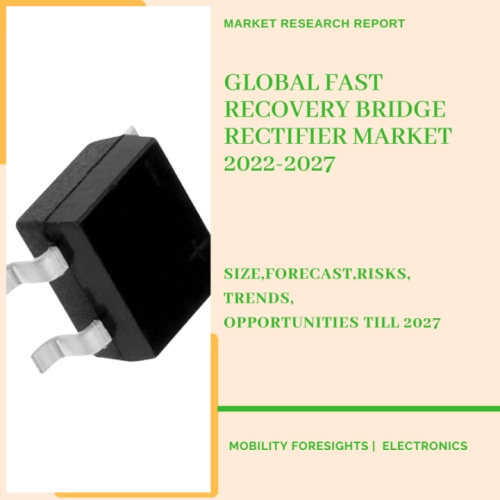
- Get in Touch with Us

Last Updated: Apr 25, 2025 | Study Period: 2022-2027
A Bridge rectifier includes all four diodes in a four-pin package and comes in a variety of package types and voltage/current choices, whereas a Fast Recovery Diode is a semiconductor device with a fast reverse recovery time for high-frequency rectification.

The rectification of a high-frequency AC signal requires a rapid recovery time. It helps to Choose diodes with enough current rating to handle the entire output current load, or twice the current rating to handle any surge current [even if the diode only conducts for half the time].
Diodes are commonly employed in rectifiers because of their extremely fast switching speed. It's ideal for applications that require frequent validation.
The Global Fast Recovery Bridge Rectifier Market accounted for $XX Billion in 2021 and is anticipated to reach $XX Billion by 2026, registering a CAGR of XX% from 2022 to 2027.
Taiwan Semiconductor released the RxBS series of 1000V bridge rectifiers with rated currents of 2A, 3A, and 4A.
By decreasing the amount of external filtering required and hence the components count and bill-of-material costs, the surface mounts architecture simplifies compliance with electromagnetic compatibility (EMC) regulations.
Kevin Parmenter, FAE director at Taiwan Semiconductor, underlined the series' major benefits of the product,
The reverse recovery time, or Trr, is on the order of 300 ns, which helps to fulfil worldwide EMC requirements without the need for extra filters while reducing conducted emissions. Alternatively, depending on the market's norms, less screening can be necessary.
Furthermore, a forward voltage of 1.30 V at Tj=25°C / 1.16 V at Tj=125°C optimises efficiency and thermal performance.
Surface-mount packages boost power density by reducing thermal resistance and managing heat dissipation without the need for additional heat sinks or the use of the PCB as a heat spreader.
| Sl no | Topic |
| 1 | Market Segmentation |
| 2 | Scope of the report |
| 3 | Abbreviations |
| 4 | Research Methodology |
| 5 | Executive Summary |
| 6 | Introduction |
| 7 | Insights from Industry stakeholders |
| 8 | Cost breakdown of Product by sub-components and average profit margin |
| 9 | Disruptive innovation in the Industry |
| 10 | Technology trends in the Industry |
| 11 | Consumer trends in the industry |
| 12 | Recent Production Milestones |
| 13 | Component Manufacturing in US, EU and China |
| 14 | COVID-19 impact on overall market |
| 15 | COVID-19 impact on Production of components |
| 16 | COVID-19 impact on Point of sale |
| 17 | Market Segmentation, Dynamics and Forecast by Geography, 2022-2027 |
| 18 | Market Segmentation, Dynamics and Forecast by Product Type, 2022-2027 |
| 19 | Market Segmentation, Dynamics and Forecast by Application, 2022-2027 |
| 20 | Market Segmentation, Dynamics and Forecast by End use, 2022-2027 |
| 21 | Product installation rate by OEM, 2022 |
| 22 | Incline/Decline in Average B-2-B selling price in past 5 years |
| 23 | Competition from substitute products |
| 24 | Gross margin and average profitability of suppliers |
| 25 | New product development in past 12 months |
| 26 | M&A in past 12 months |
| 27 | Growth strategy of leading players |
| 28 | Market share of vendors, 2022 |
| 29 | Company Profiles |
| 30 | Unmet needs and opportunity for new suppliers |
| 31 | Conclusion |
| 32 | Appendix |